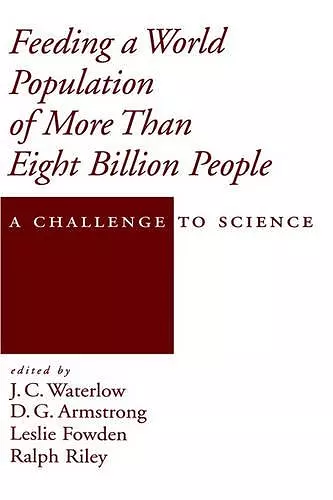Feeding a World Population of More Than Eight Billion People
A Challenge to Science
J C Waterlow editor D G Armstrong editor Sir Leslie Fowden editor Sir Ralph Riley editor
Format:Hardback
Publisher:Oxford University Press Inc
Published:30th Jul '98
Currently unavailable, and unfortunately no date known when it will be back

Since the 1960s the steadily increasing availability of food, arising from the application of new agricultural science, has exceeded the demands created by the growth in size of the human population of the world. However, the 1990 world population of 5.5 billion is projected to grow to 10 billion by 2050. Can the future demand for food be satisfied? This question is particularly difficult given that even in 1990 1.1 billion people in developing countries were living in poverty and more than 500 million in extreme poverty. This book, based on the proceedings of the 10th International Symposium sponsored by the Nutrition Committee and the Trustees of the Rank Prize Funds, in 1996, addresses the question of how to feed the projected population a generation from now and discusses the challenges this presents. The topics covered include land and crop nutrients and sustainability, natural resource management, water usage, applications of science to increase yield, the role of animal products in feeding people, and social aspects such as introducing new technology and the processes through which greater food security may be attained. The contributors are world authorities in their fields, and the book will benefit a wide range of professional workers in the agricultural sciences and in government agencies.
"This book is based on the 10th International Symposium sponsered by the Nutrition Committee and the Trustees of the Rank Prize Funds. It examines the immediate challenges of feeding a growing human population just a generation from now. The 19 individually authored articles in this book cover a broad range of topics, from food economics to resource allocation and crop yields. The book is an invaluable resource for a wide range of those interested in agriculture, the environment, and public policy." --Biosis, Vol 51, Issue 3, March 1999 "This book . . . is truly an interdisciplinary effort. The 19 chapters are divided into five parts, each with a synopsis. . . . The total length of the book (280 pages) is not formidable. Each chapter is well referenced, and the book has an excellent index. The setting by Aaron Klug in the Introductory Remarks raises the premise, supported by most demographers, that the 6 billion people on earth now will have expanded to at least 8 billion by 2050. Can these people be fed, and what is the role of science in the quality and quantity of food by 2050? . . . Overall, this is a book that is great for the reference shelf and a good textbook for a course on population and sustainable development. I will use it often because of its large number of references and its well documented facts and figures. It will save me from hunting to find the right statistic for a talk. It is diverse, as is the topic. I recommend it for all resource planners and those in global agriculture studies."--Soil Science "This book is based on the 10th International Symposium sponsered by the Nutrition Committee and the Trustees of the Rank Prize Funds. It examines the immediate challenges of feeding a growing human population just a generation from now. The 19 individually authored articles in this book cover a broad range of topics, from food economics to resource allocation and crop yields. The book is an invaluable resource for a wide range of those interested in agriculture, the environment, and public policy." -- Biosis, Vol 51, Issue 3, March 1999
ISBN: 9780195113129
Dimensions: 236mm x 160mm x 23mm
Weight: 567g
296 pages